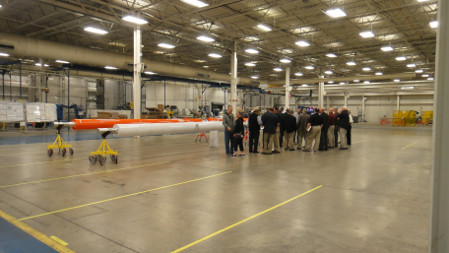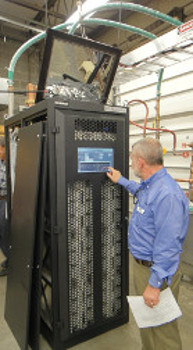IEEE-BTS Symposium Tackles Repack Complexity
I first attended the IEEE Broadcast Symposium 20 years ago when it was held at the Hotel Washington and it remains the “must attend” event of the fall conference schedule. This year’s symposium in Hartford, Conn., was well attended, with many local broadcast engineers and engineering students attending the sessions; the papers were interesting and relevant; and the food, hospitality and conversations at lunches and receptions were excellent.
PRE-SYMPOSIUM TOURS
The day before the symposium, attendees had an opportunity to tour the RFS facility in Meriden, Conn. and Hitachi-Comark, in Southwick, Mass. The RFS tour gave attendees a chance to see what RFS was doing to prepare for the repack. The group saw the space RFS had reserved for building antennas for the repack (Fig. 1) and also heard about its software and technology for optimizing slot antenna patterns.

RFS room for repack antennas
At the Hitachi-Comark plant, the company had a fully loaded PARALLAX solid-state UHF TV transmitter putting 27.5 kW into a dummy load (Fig. 2). The group was able to see the transmitter’s performance on an ETL analyzer. We also had a chance to see how the transmitter was assembled. The modular design makes it easy to build transmitters for different power levels and should allow Comark to ramp up production as needed to meet demands for transmitters as part of the repack.
REPACK PRESENTATIONS
The papers covered a wide range of topics of interest to broadcast engineers, with several focusing on new technology and technical regulatory issues like the upcoming repack of TV channels. I’ll cover repack issues this month and in future columns, I’ll discuss presentations that describe application of new technologies for the repack and the transition to ATSC 3.0.
Even though two stages of the FCC’s incentive auction had been completed before the symposium ended, many questions remained about what broadcasters would have to do to move to their new channels when the auction ended and how they would be reimbursed.
Joe Davis, president and founder of Chesapeake RF Consultants LLC, presented a “TV Repack Update—Wait, and Hurry Up!” The FCC has provided a beta test of the Schedule 399, Form 2100 online for reimbursement of eligible expenses and Davis outlined the items in Schedule 399, noting that the FCC wants to see a description of the station’s plan for changing channels. If facilities are shared (tower, antenna, site), the commission wants to see the other stations sharing the site to make sure the sum of the reimbursements for the shared items doesn’t exceed 100 percent of what’s allowed. He said the FCC will be updating the reimbursement cost soon. [As of this writing, the beta test of Schedule 399 has ended, but new costs have not been released.]
Davis summarized the various filing windows opening after release of the channel assignment Public Notice. I’ve covered the filing windows in a previous column, but to summarize, they include a window ending three months after the Public Notice is released for filing construction permits for the FCC assigned facilities; a priority station filing window after that for modified facilities for stations with excessive loss of population or for stations that received a waiver of the original CP deadline; and a non-priority station window where stations can request expanded facilities and alternate channels. Digital LPTV and translator stations on the air when the Public Notice is released will have a window to file for a displacement channel and, finally, full-power stations that are not repacked will see the freeze on contour extension and channel substitution lifted.

Full power PARALLAX operating at Comark
Davis said expansion and channel change proposals will be viewed unfavorably if they impact the repack. He noted that the FCC’s phased approach seems to be in conflict with the goal of clearing wireless spectrum first—under the plan, high-channel number stations will be last in the daisy chain.
After describing how the FCC staged the transition modeling based on the time it takes to receive permit approvals, install antennas, etc., he noted, ironically, the FCC didn’t see availability of RF consultants and structural engineers as an issue. Why? Because the FCC requires them to finish in three months! Download Davis’ presentation at www.rf-consultants.com/ieee.
IMPACT OF REPACK ON FM STATIONS
FM stations have been ignored in the FCC’s repack planning, and Jim Stenberg, principle engineer, broadcast RF for American Tower Corp., sees that causing problems for TV and radio broadcasters alike. In his presentation, “TV Repack Implications for FM Station Operations,” Stenberg estimated 1,153 towers in the United States have co-located FM and TV and 2,368 FM radio stations and translators could be impacted by the repack, based on FCC and ASRN data. Very few of these have auxiliary transmitters on different towers.
Obviously, extensive tower work related to the repack will impact FM stations. Tower lease agreements with limited windows for FM power reductions or shutdowns could significantly delay repack tower. The obvious solution, Stenberg noted, is for FM stations to have an off-site auxiliary facility. He said most master FM systems can handle one or more aux stations, depending on physical space and power handling capability.
There is a problem though. Who pays for it? The incentive auction Report and Order states, “For example, where multiple stations share a tower, a reassigned station that makes changes may be required to cover certain expenses incurred by other tower occupants. In such circumstances, the Commission will consider a claim from the reassigned station for reimbursement of such costs, so long as the reassigned broadcaster has a contractual obligation to pay these expenses through a contract entered into on or before [June 2, 2014].”
Stenberg noted that most stations’ lease agreements do not have such a contractual obligation. He said ATC has asked for clarity on how this will affect FM stations on TV towers, but as of his presentation, FM stations were not directly able to submit (or have the TV station submit) expense reimbursement for temporary auxiliary facilities in most cases.
If you are interested in copies of the presentations, contact the authors or IEEE Broadcast Technology Society (BTS) to check on availability. If you are not a member of IEEE BTS, consider joining!
Doug Lung is vice president of Broadcast Technology, NBC/Telemundo stations.He welcomes your comments and questions. Email him at dlung@transmitter.com.
Get the TV Tech Newsletter
The professional video industry's #1 source for news, trends and product and tech information. Sign up below.

Doug Lung is one of America's foremost authorities on broadcast RF technology. As vice president of Broadcast Technology for NBCUniversal Local, H. Douglas Lung leads NBC and Telemundo-owned stations’ RF and transmission affairs, including microwave, radars, satellite uplinks, and FCC technical filings. Beginning his career in 1976 at KSCI in Los Angeles, Lung has nearly 50 years of experience in broadcast television engineering. Beginning in 1985, he led the engineering department for what was to become the Telemundo network and station group, assisting in the design, construction and installation of the company’s broadcast and cable facilities. Other projects include work on the launch of Hawaii’s first UHF TV station, the rollout and testing of the ATSC mobile-handheld standard, and software development related to the incentive auction TV spectrum repack. A longtime columnist for TV Technology, Doug is also a regular contributor to IEEE Broadcast Technology. He is the recipient of the 2023 NAB Television Engineering Award. He also received a Tech Leadership Award from TV Tech publisher Future plc in 2021 and is a member of the IEEE Broadcast Technology Society and the Society of Broadcast Engineers.
